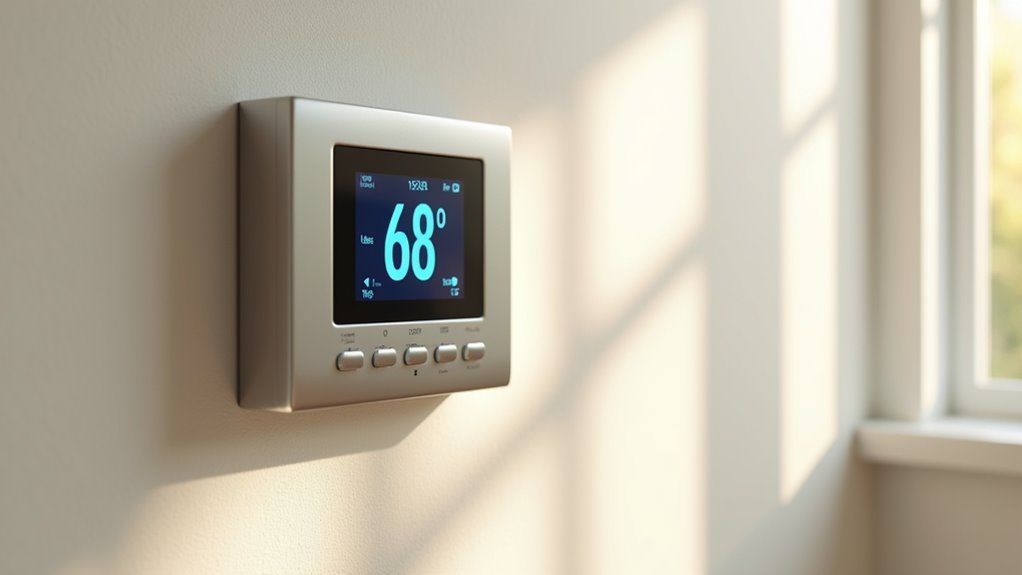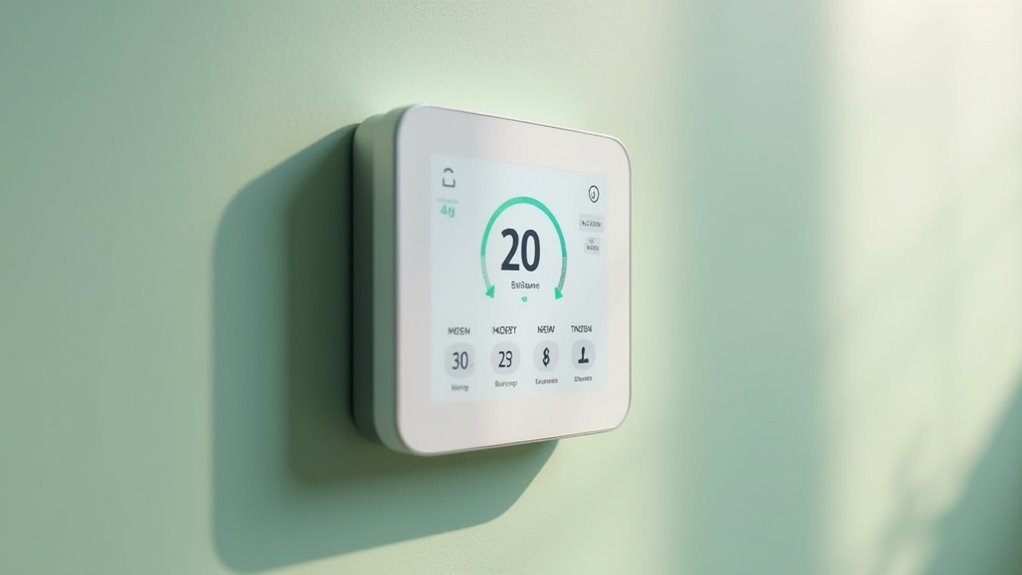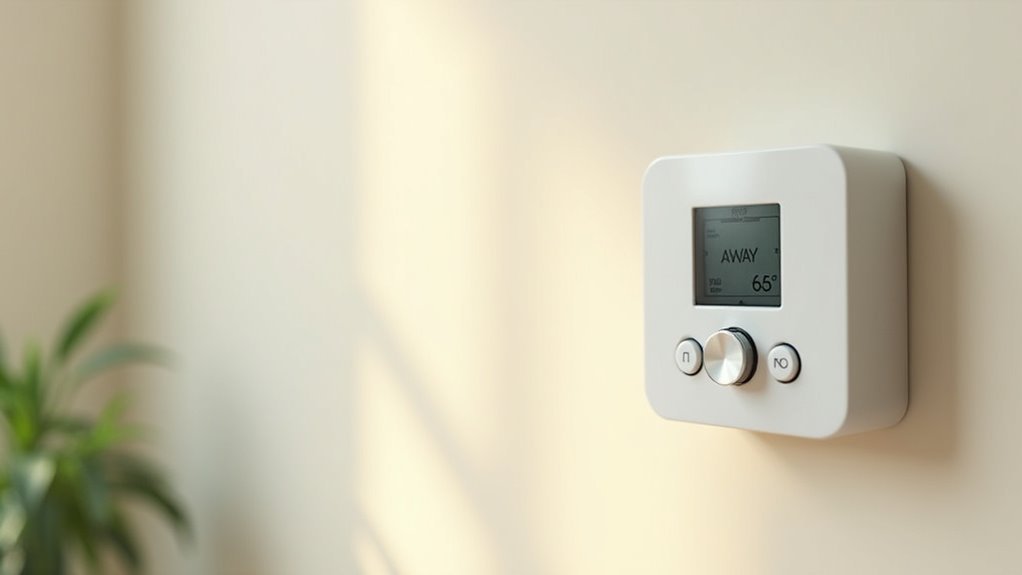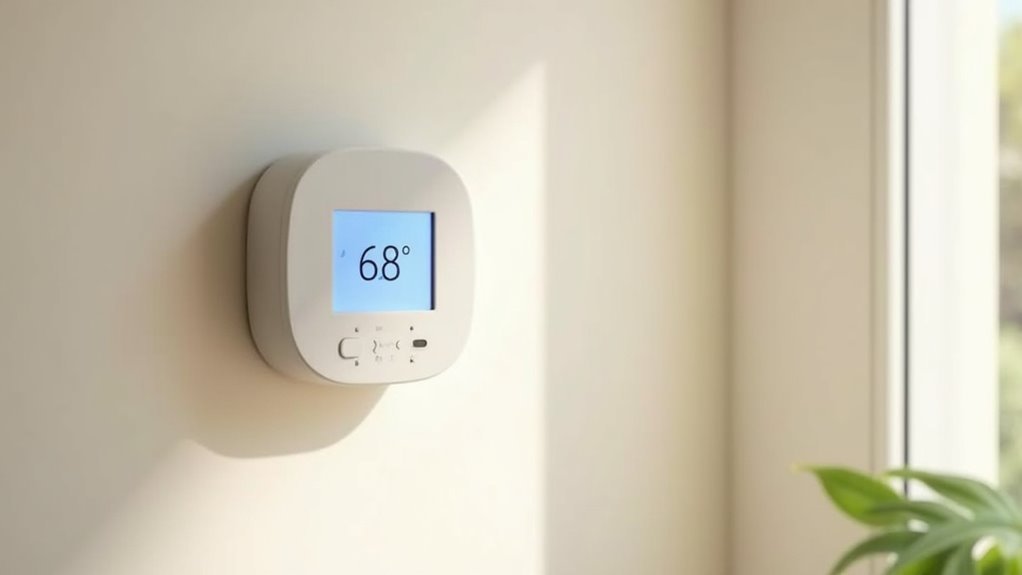You’re probably leaving money on the table every month without realizing it. Your thermostat holds the key to cutting energy costs by up to 23% annually, yet most homeowners barely scratch the surface of what’s possible. While you’ve likely heard basic advice about adjusting temperatures, there’s a collection of strategic hacks that go far beyond simple setbacks—techniques that could transform your monthly utility bills entirely.
Set Strategic Temperature Schedules Based on Your Daily Routine

When you align your thermostat settings with your daily schedule, you’ll transform energy waste into significant savings without sacrificing comfort.
Set your thermostat to automatically lower the temperature by 7-10°F during nighttime hours and when you’re away for extended periods – this simple adjustment can save up to 10% on your heating bills annually.
Lower your thermostat 7-10°F overnight and while away to cut heating costs by 10% annually.
Use a programmable or smart thermostat to create temperature schedules that match your routine perfectly.
During winter, maintain 68°F when home, then program cooler temperatures while sleeping or away.
For summer efficiency, set 75-78°F during occupied hours and 80°F when absent.
Your HVAC system will work more efficiently with these strategic schedules, reducing energy consumption while maintaining peak comfort throughout your daily routine.
Program Automatic Temperature Reductions During Sleep Hours
Programming your thermostat for nighttime temperature reductions represents one of the most effective strategies within your daily scheduling routine.
When you program automatic temperature adjustments during sleep hours, you’ll achieve substantial energy savings while maintaining comfort. A smart thermostat makes this process effortless by learning your patterns and optimizing thermostat settings accordingly.
Here’s how to maximize nighttime efficiency:
- Set temperature recommendations of 60-65°F during sleep – This ideal temperature range will enhance sleep quality while reducing energy costs.
- Program automatic reductions of 7-10°F – You’ll save up to 10% on heating bills annually.
- Use smart thermostat features – Automatic scheduling eliminates manual adjustments.
- Reduce workload on your HVAC system – Lower nighttime temperatures decrease system strain and increase efficiency.
Install Smart Thermostats for Adaptive Learning Capabilities

While nighttime programming creates immediate savings, smart thermostats with adaptive learning capabilities take efficiency to the next level by automatically enhancing your home’s temperature based on your unique patterns and preferences.
These devices monitor your daily routines and adjust heating and cooling settings without manual intervention, reducing energy use by up to 20% annually.
Smart thermostats learn your schedule and automatically optimize temperature settings, delivering up to 20% energy savings without any effort on your part.
You’ll gain remote control through smartphone apps, allowing you to monitor and adjust temperatures from anywhere.
Smart thermostats analyze energy consumption patterns, providing insights that reveal additional savings opportunities. They integrate seamlessly with home automation systems and weather forecasts, making real-time adjustments based on current conditions.
This adaptive learning technology continuously fine-tunes settings, ensuring peak comfort while maximizing efficiency.
Implement Zoning Systems for Targeted Climate Control
Beyond smart thermostats’ adaptive learning features, zoning systems revolutionize home climate control by dividing your house into independent temperature zones that you can manage separately.
This targeted approach delivers exceptional comfort while dramatically cutting energy costs through reduced energy waste in unused spaces.
Here’s how zoning systems maximize HVAC efficiency:
- Customize temperature settings for each zone based on actual usage, maintaining comfort in occupied areas while reducing heating/cooling elsewhere.
- Achieve up to 30% energy savings by avoiding uniform temperature maintenance throughout your entire home.
- Integrate smart thermostats that learn occupancy patterns and automatically optimize each zone’s operation.
- Schedule regular maintenance including inspections and calibrations to guarantee peak performance and prevent increased energy bills.
This strategic approach prevents your HVAC system from overworking unnecessarily.
Utilize Away Mode Features for Unoccupied Periods

When you leave your home unoccupied, smart thermostat Away Mode features automatically enhance energy consumption by adjusting temperatures to predetermined levels—typically 80°F during summer months and 60-65°F in winter.
You’ll achieve significant energy savings by setting back your thermostat 7-10 degrees during unoccupied periods, which can reduce heating costs and cooling costs by up to 10% annually according to the Department of Energy.
You can configure specific schedules for Away Mode to guarantee peak energy efficiency without sacrificing comfort upon return.
Advanced smart thermostats detect when you leave and automatically activate Away Mode, eliminating manual adjustments.
This consistent approach prevents your HVAC system from overworking, reducing wear and extending equipment lifespan while maintaining efficient operation.
Monitor Real-Time Energy Usage and Consumption Patterns
Smart thermostats transform your energy management approach by providing real-time insights into heating and cooling consumption patterns.
You’ll receive weekly reports highlighting energy usage trends, enabling you to identify peak consumption times and enhance thermostat settings effectively.
By tracking temperature adjustments and occupancy patterns, you can reduce energy costs by up to 20% annually.
Real-time energy usage monitoring reveals how minor changes—adjusting your thermostat just a few degrees—create significant savings over time.
- Monitor daily consumption patterns to identify when your HVAC systems consume the most energy
- Track temperature adjustments against actual usage to find your ideal comfort-efficiency balance
- Analyze occupancy patterns to automatically adjust settings when rooms are unoccupied
- Receive instant alerts about unusual energy spikes for proactive HVAC management and enhanced energy efficiency
Calibrate Your Thermostat for Accurate Temperature Readings
While monitoring energy consumption provides valuable insights, accurate temperature readings form the foundation of efficient thermostat operation.
You’ll need to calibrate your thermostat regularly to maintain peak HVAC efficiency. Position it away from direct sunlight, drafts, and heat sources that skew readings and force your system to overwork.
Use a separate thermometer to verify accuracy—if there’s more than a 1-2°F discrepancy, recalibration’s necessary. Follow manufacturer instructions for calibration, as slight miscalibrations can create several degrees difference, undermining your energy-saving efforts.
Consider upgrading to a programmable or smart thermostat that automatically adjusts based on learned behavior patterns.
Schedule annual maintenance to verify your thermostat and HVAC system function properly, preventing up to 10% efficiency losses while maximizing your energy savings.
Optimize Thermostat Placement for Better Performance
You’ll greatly improve your thermostat’s performance by choosing the right location in your home.
Place your thermostat on an interior wall about 5 feet high, away from direct sunlight, drafts, and any heat-producing appliances like ovens or lamps.
This strategic positioning guarantees accurate temperature readings and prevents your HVAC system from working harder than necessary.
Strategic Location Selection
Although many homeowners focus on programming and settings, thermostat placement determines whether your HVAC system operates efficiently or wastes energy fighting false readings.
Your thermostat’s location directly impacts temperature readings and overall energy efficiency.
Follow these strategic placement guidelines:
- Mount on an interior wall away from windows, doors, and drafts that create misleading temperature fluctuations.
- Choose a central part of your home within frequently used living spaces for accurate representation of overall comfort levels.
- Avoid heat sources like lamps, televisions, and appliances that trigger unnecessary heating or cooling cycles.
- Keep away from direct sunlight to prevent solar heat from skewing sensor readings.
Regularly clean the area around your thermostat to guarantee unobstructed sensors maintain peak performance.
Avoid Heat Sources
Why does your heating bill spike even when you’ve programmed your thermostat correctly? Heat sources around your thermostat sabotage accurate temperature readings, forcing your HVAC system to cycle unnecessarily.
Keep your thermostat away from direct sunlight, air vents, and appliances that generate heat. These sources trick your device into thinking the room’s warmer than it actually is. Similarly, avoid placing it near drafty windows or doors where cold air creates false readings.
| Heat Source | Impact | Solution |
|---|---|---|
| Direct sunlight | False high readings | Install away from windows |
| Air vents | Premature cycling | Choose neutral wall space |
| Appliances | Inaccurate sensors | Maintain 5+ foot distance |
Clean the area regularly to prevent dust buildup that interferes with sensors. Your programmable thermostat’s energy-saving hacks depend on proper placement for ideal temperature settings and reduced energy usage.
Integrate Weather-Based Automatic Adjustments
When outdoor temperatures fluctuate dramatically, your thermostat’s ability to anticipate and respond to weather changes becomes a game-changer for energy efficiency.
Smart thermostat systems with weather-based automatic adjustments can reduce your energy costs by up to 20% annually while maintaining ideal comfort levels.
Here’s how weather-integrated systems maximize your HVAC efficiency:
- Preemptive temperature control – Your thermostat adjusts heating or cooling before extreme weather arrives, preventing energy waste.
- Real-time outdoor temperature adaptation – Settings automatically modify based on current conditions outside your home.
- Humidity-based optimization – The system won’t overcool when natural air conditions already provide comfort.
- HVAC longevity protection – Proper load management during temperature extremes reduces wear and extends your system’s lifespan.
These automatic saving features work continuously without requiring your constant attention.
Maintain Consistent Settings to Reduce HVAC System Strain
While weather-based adjustments enhance your thermostat’s response to external conditions, maintaining consistent internal temperature settings prevents unnecessary strain on your HVAC system.
Frequent temperature changes force your equipment to work harder, reducing energy efficiency and increasing costs. Instead of dramatic swings, make small adjustments of about 4°F to save up to 10% on heating bills annually.
Set your ideal thermostat setting at 68°F during winter and 75-78°F in summer, then resist constant changes.
Avoid cranking temperatures to extremes thinking it’ll heat or cool faster—it won’t. A steady temperature allows your HVAC system to maintain peak performance, helping reduce energy costs while preventing excessive wear.
This consistency will extend lifespan and minimize expensive repairs.
Frequently Asked Questions
What Is the Most Energy Efficient Way to Set a Thermostat?
Set your thermostat to 68°F when home in winter, 60-65°F when away. Use 75-78°F in summer, 80°F when absent. You’ll save up to 10% annually with these adjustments.
Is 70 Too High for a Thermostat in Winter?
Yes, 70°F is too high for winter energy efficiency. You’ll increase heating costs by 6-10% compared to the recommended 68°F. Lower your thermostat to 60-65°F when sleeping or away for maximum savings.
Is It Cheaper to Leave Your Thermostat at One Temperature?
You’ll save more by adjusting your thermostat strategically rather than keeping it constant. Setting it back 7-10°F for eight hours daily can cut your heating bills by up to 10% annually.
How Do I Set My Thermostat to Maximum Energy Savings?
You’ll maximize energy savings by programming temperature setbacks of 10-15 degrees when away or sleeping. Set winter temps to 68°F when home, 60-65°F away. Summer: 75-78°F home, 80°F away.





Leave a Reply